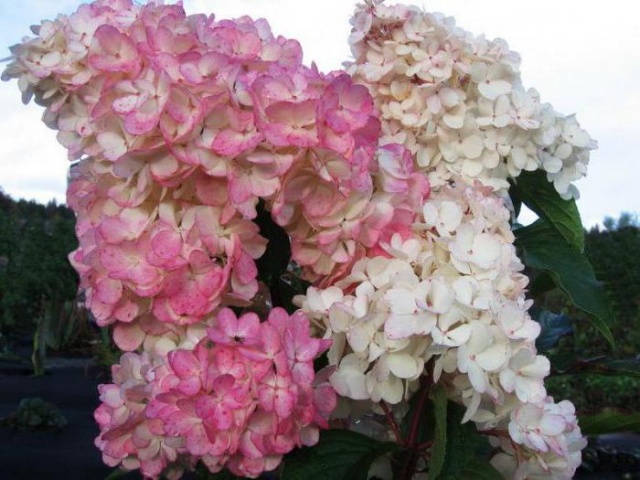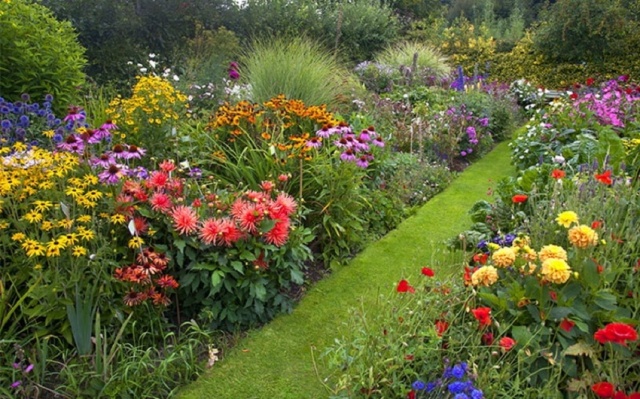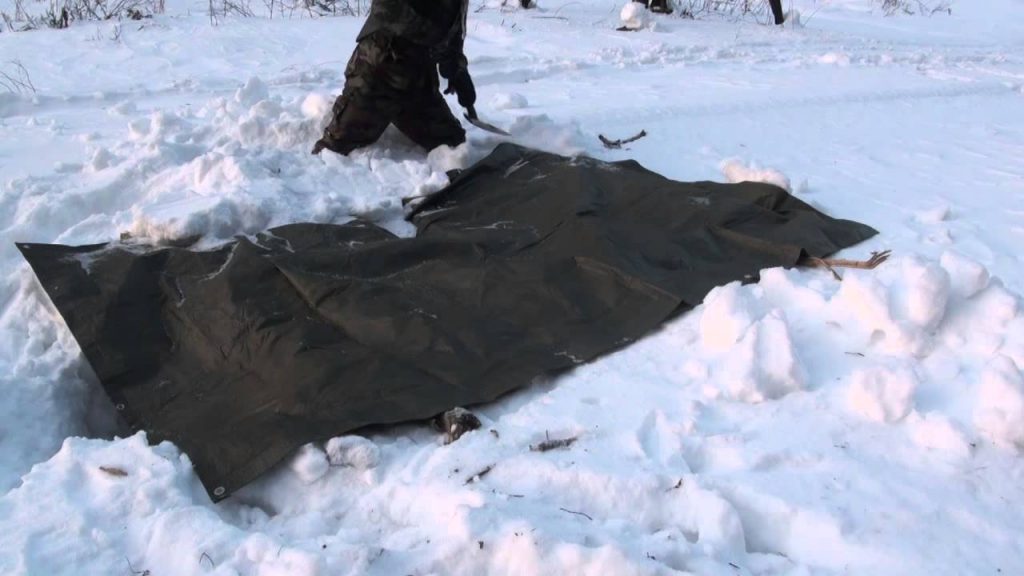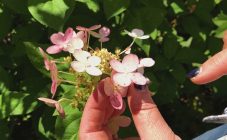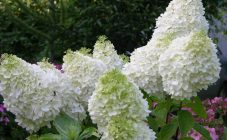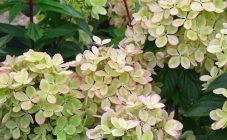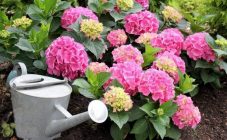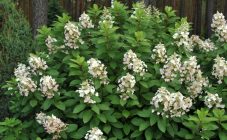Content:
Plants of the hydrangea family represent a separate classification of flowers. Mostly these are perennial trees and shrubs, gaining a height of up to 3 m and belonging to the deciduous group. But you can also find special subtropical liana-like varieties that can grow up to 30 m in length, among which there are many evergreen representatives.
Hydrangeas bloom for 5-6 months, from spring to late autumn. The bush can produce thyroid, paniculate or spherical inflorescences. The color of flowers can be very diverse: from deep blue to pale yellow. The Pink Lady hydrangea deserves special attention, which P. Zweinenburg managed to breed. The work on creating a new variety was carried out for a very long time and painstakingly, and the result met all expectations!
Description of Pink hydrangea
Pink Lady is a separate panicle hydrangea variety. It grows in the form of a spreading tree-like bush up to 2 m high. The leaves are large and jagged at the edges. The elongated branch is completely covered with greenery, and at the top there is an inflorescence.
The flowers of the Pink Lady hydrangea are cone-shaped and are at a close distance from each other, which makes the shrub look very voluminous and luxuriant. Each panicle is 15–20 cm in diameter. The flower petals themselves are whitish, but as they grow, they become pinkish. It is because of this that this variety got its name.
Planting and growing
Pink Lady is a hydrangea without any special requirements and whims. She is not afraid of drought and stagnant water. Since the plant is strong, it can adapt to every type of soil, but in no case should it be planted in soil with a high lime content. She will feel best in an acidic type of soil.
When preparing the land for planting a hydrangea seedling, if possible, you should choose a mixture of leafy earth, peat, sand and humus, and then artificially acidify it. The beauty and subsequent development of the bushes directly depends on the preparation of the planting material. In addition to the soil, you need to pay attention to the purchased seedlings, selecting the strongest among all.
The best time to plant Pink Lady panicle hydrangea in open ground is spring, but autumn is also suitable, but then additional efforts will be required.
If the planting turns out to be carried out in the spring, then the plant will have a whole summer to get accustomed to new conditions. If autumn was chosen, then a winter shelter is prepared for the seedlings, which is necessary for young plantings in any scenario, regardless of the frost resistance of the variety.
After the soil has been prepared, the next step is to dig a hole under the bush. It will take a lot of space, since the hole should be spacious enough (not less than 50 × 50 cm, but not more than 80 × 80 cm). The parameters are precisely determined depending on the root system of the seedling. Before direct planting, it is recommended to fertilize the hole with superphosphates, urea, and pour 2-3 buckets of water overnight so that the earth is saturated with moisture.In the morning everything will be ready and you can place the plant.
Hydrangea care
Hydrangea paniculata Pink Lady needs watering, feeding, regular pruning and protection from various pests. If the region is cold, then additional preparation of the flower culture for wintering will be needed.
In particular, the most important thing to know about watering Pink hydrangea is that it loves moisture. The bush needs a lot of water to form inflorescences. Usually this variety is watered once a week. On average, one bush takes up to 8-10 liters of water. If the season is too hot and dry, then the number of irrigations is increased up to 2-3 times. The most suitable water is slightly warm and settled for at least a few days.
In addition, when watering, gardeners often face such a problem as exposing the roots of the bush. It is extremely undesirable; mulching the earth with humus will help.
Another important element in the care of Pink Lady is the enrichment of hydrangeas with nutrients. Both organic and minerals are suitable. The ideal option is to use both one and the other in turn. Fertilizing at a certain time:
- in the spring, until the buds have blossomed (using organic matter);
- at the moment when the first buds develop (organic matter is also best suited);
- in the middle of the summer season (mineral complexes are used: ammonium nitrate, potassium salt);
- when the flowering ended in the fall (both organic and mineral fertilizers are suitable, but the main thing is that there is no nitrogen).
In order to get large and beautiful inflorescences, in addition to feeding, the plant is pruned. In the spring, the Pink Lady hydrangea shortens the shoots, leaving only 6–8 buds, but they do this before the sap flow begins. They get rid of sick and weak shoots without fail. With the onset of summer, pruning is no longer performed, since the removal of dry inflorescences during this period is already sufficient for the plant to form new buds.
By the time the flowering ends, it is worth taking care of the shelter of the bush for the winter. The Pink variety is characterized by increased resistance to cold, since it can withstand up to -29 ° C, therefore, basically, the shelter needs to be prepared for residents of cold regions and those who still have very young seedlings. In cold weather, when there is no snow cover, the roots of hydrangea are mulched with a layer of dry leaves or humus (thickness 20–30 cm). Young seedlings are additionally covered with agrofibre or burlap. When snow appears, a snowdrift is thrown on top of the bush.
Diseases and pests of Pink Lady hydrangea: control measures
With the arrival of wet and cold weather, hydrangea becomes vulnerable to fungal diseases. During such periods, signs of powdery mildew are often found on its branches - a white bloom on the leaves and shoots. To get rid of the disease, fungicides are used, for example, foundationol, topaz, quadris. It is necessary to process the bush with a solution in the morning and evening. Each drug has an instruction, which indicates how much water it should be diluted with.
Another dangerous fungal infection for Pink Lady is tracheomycotic wilting. The disease first affects the roots, slowly spreading through the vascular system of the flower. The affected plant stops receiving the required amount of nutrition from the soil, which is why it begins to wither. The disease develops on the plant, usually at the time of cuttings or due to a sharp change in weather. And it can be stopped only in the early stages with the preparations of Fundazol, Topsin-M and Vitaros. If the disease has become severe, then nothing can be done to help the hydrangea, the bush must be immediately destroyed so as not to infect the rest of the plants in the garden.
Another disease that all owners of panicle hydrangeas should know about is gray rot.You can notice its presence by gray spots on the stems and leaves. Over time, the spots become darker, expanding and increasing in size. With gray rot, the leaves quickly collapse, and then a hole forms in the plate. The cause of the development of the disease is excessive water overflow. All parts of the bush that have died out due to rot are removed, and then the plant is treated with a foundation or soon.
Of the pests, bugs, spider mites, pennies and aphids can attack the Pink hydrangea. The last parasite deals especially strong damage. Insecticides are used against aphids: fitoverm, trichopol. Several treatments will be required per season.
Another hydrangea lover is snails. They are already collected and removed from the site with their own hands.
Hydrangea Pink Lady in landscape design
Hydrangea panicle Pink Lady is a real find for landscape designers who happily use this variety to transform gardens and various areas. Long flowering time, resistance to cold weather, relatively easy maintenance make it very popular.
It should be borne in mind that a small seedling will soon grow into a 2-meter bush, it will need a lot of space and a border zone with neighboring plants. Therefore, when modeling a site design, you need to think about neighboring flowers or trees.
A significant plus of Lady Pink is that she will suit any design style, be it a group or single landing. Landscape designers advise every gardener to combine hydrangeas with conifers, as their colors are extremely harmonious together. However, regardless of the chosen seat, Pink Lady hydrangea will always stand out for its beauty and enchanting flowering. It is not for nothing that the London royal community recognized this paniculata variety as one of the most sought-after and chosen among the rest of the hydrangeas.
